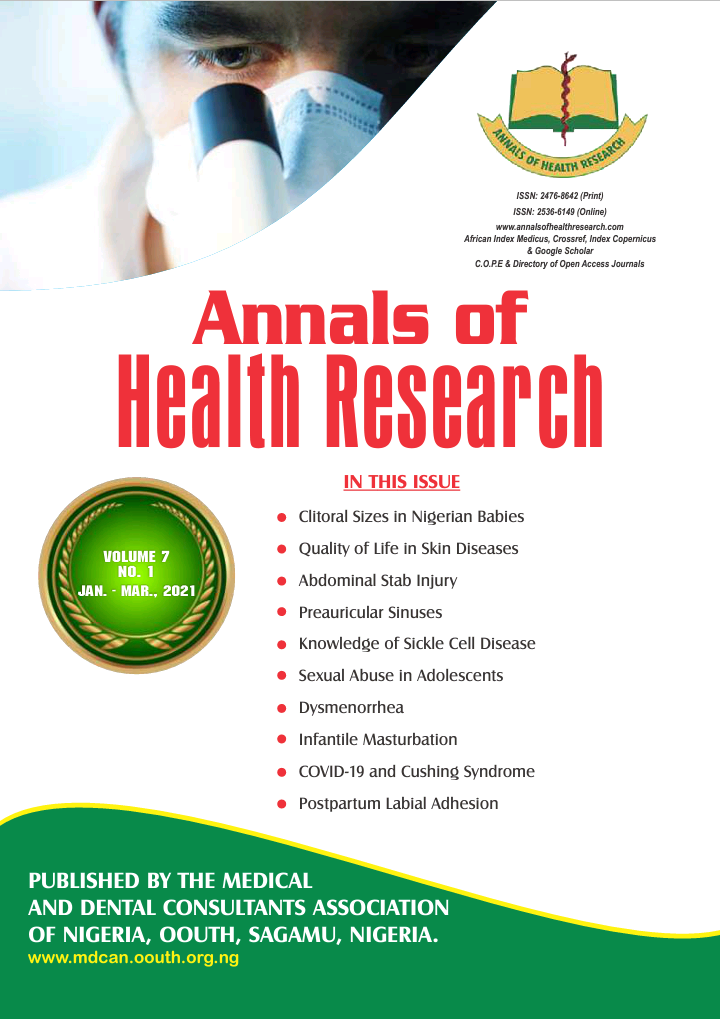Comparative study of neonatal clitoral length measurement using calliper and spatula
DOI:
https://doi.org/10.30442/ahr.0701-01-110Keywords:
Calliper, Clitoral length, Newborn, SpatulaAbstract
Background: When standard instruments are unavailable for clitoral length measurement, improvisation with locally available tools could be of diagnostic value.
Objective: The objective of this study was to determine how the clitoral length measured with a wooden spatula compared to that measured with a caliper.
Methods: This was a comparative cross-sectional study. Three hundred and five term female infants were recruited from multiple health facilities in Sagamu, Ogun State, Nigeria. The clitoral length was measured with a sliding digital caliper and a wooden spatula (tongue depressor). All the measurements were taken within the first 72 hours of life and comparative analysis was carried out.
Results: The mean (± SD) clitoral length using the sliding digital caliper and the spatula were 6.7 ± 1.6 mm and 6.5 ± 1.8 mm respectively. There was no statistically significant difference between the mean values of both measurements (t = 1.369, p = 0.171). Pearson’s correlation showed that both variables were significantly correlated (r = 0.693, p < 0.001) and the spatula length was a moderate predictor of the caliper length (Coefficient of determination [R2] = 0.48 and p < 0.001).
Conclusion: The findings of this study suggest that the determination of clitoral length using a spatula, commonly found in all community settings, is similar to determination of clitoral length using a digital caliper, most often used for clinical research.
References
Moore KL, Persaud TV. The urogenital system. In: The developing human: clinically oriented embryology. 7th edition. Philadelphia: Saunders, Elsevier; 2003: 304-320.
Oberfield SE, Mondok A, Shahrivar F, et al. Clitoral size in full term infants. Amer J Perinatol 1989; 6: 453–454. doi:10.1055/s-2007-999638.
Kutlu HA, Akbiyik F. Clitoral length in female newborns: a new approach to the assessment of clitoromegaly. Turk J Med Sci 2011; 41: 495-499. doi:10.3906/sag-1006-907.
Kessler, Suzanne J. 1998. Lessons from the Intersexed. New Brunswick, NJ: Rutgers University Press.
Jarrett OO, Ayoola OO, Jonsson B, Albertsson-Wikland K, Ritzen EM. Country-based reference values and international comparisons of clitoral size in healthy Nigerian newborn infants. Acta Paediatr 2015; 104: 1286-1290. doi:10.1111/apa.13219.
Adekoya AO, Fetuga MB, Jarrett OO, Ogunlesi TA, Chanoine JP, Adekoya AO. Clitoral sizes and anogenital distances in term newborns in Nigeria. Int J Pediatr Endocrinol 2019; 2019: 5. doi:10.1186/s13633-019-0069-6.
Montagu D, Yamey G, Visconti A, Harding A, Yoong J. Where Do Poor Women in Developing Countries Give Birth? A Multi-Country Analysis of Demographic and Health Survey Data. PLoS One 2011; 6(2): e17155. doi.org/10.1371/journal.pone.0017155.
Population Reference. Ogun State Nigeria Population Statistics Charts, Map and Location. Available at https://www.citypopulation.de>php>nigeria and accessed on 22nd October, 2020.
Power and Sample Size Determination: Sample Size for One Sample, Continuous Outcome. Available at http://sphweb.bumc.bu.edu/otlt/MPH-Modules/BS/BS704_Power/BS704_Power3.html and accessed on 6th August, 2020.
Avidime OM, Olorunsola KV, Dikko AAU. Anogenital distance of newborns and causes of variation in Zaria, Northern Nigeria. Asian J Med Sci 2011; 3: 74–78.
Centres for Disease Control and Prevention – National Health and Nutrition Examination Survey (NHANES). Anthropometry procedures manual; January 2007. Available at http://www.cdc.gov/nchs/data/nhanes/nhanes_07_08/manual_an.pdf Accessed on 6th August, 2020.
Phillip M, De Boer C, Pilpel D, et al. Clitoral and penile sizes of full term newborns in two different ethnic groups. J Pediatr Endocrinol Metab 1996; 9: 175-179.
Downloads
Published
Issue
Section
License
The articles and other materials published in the Annals of Health Research are protected by the Nigerian Copyright laws. The journal owns the copyright over every article, scientific and intellectual materials published in it. However, the journal grants all authors, users and researchers access to the materials published in the journal with the permission to copy, use and distribute the materials contained therein only for academic, scientific and non-commercial purposes.


